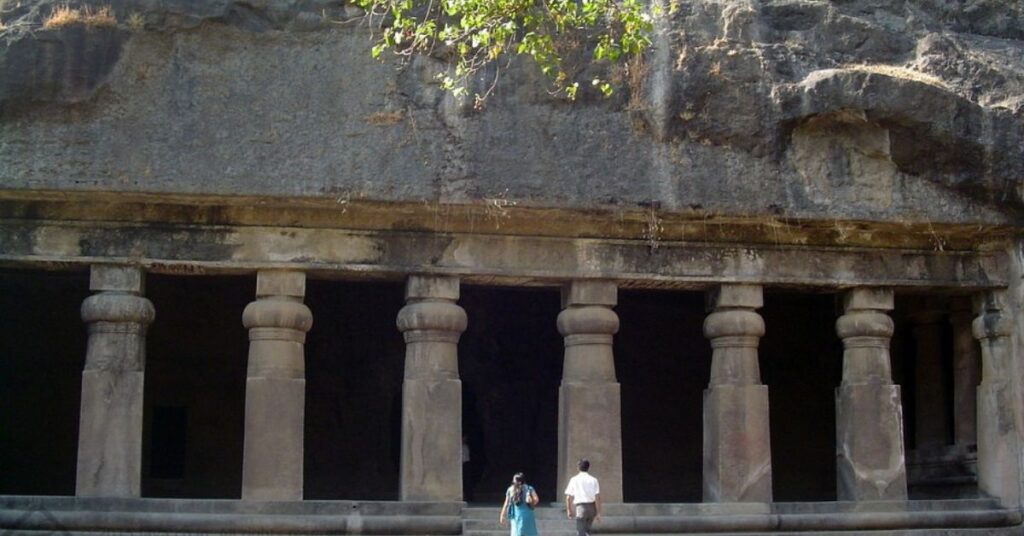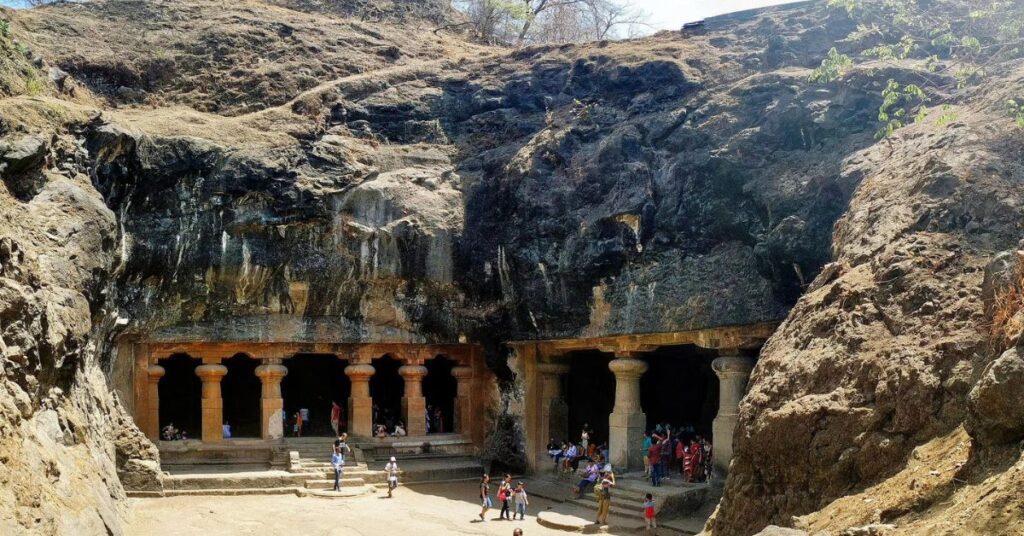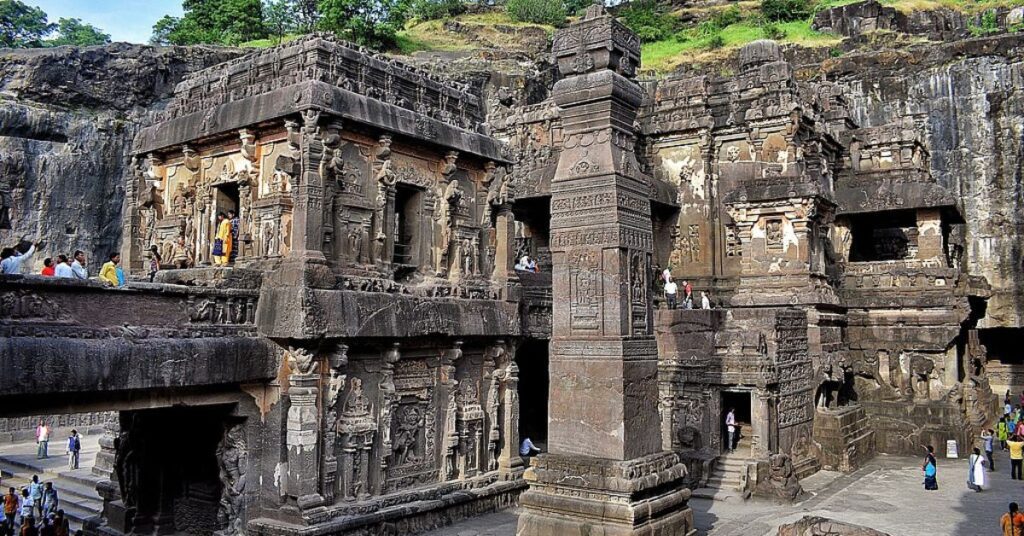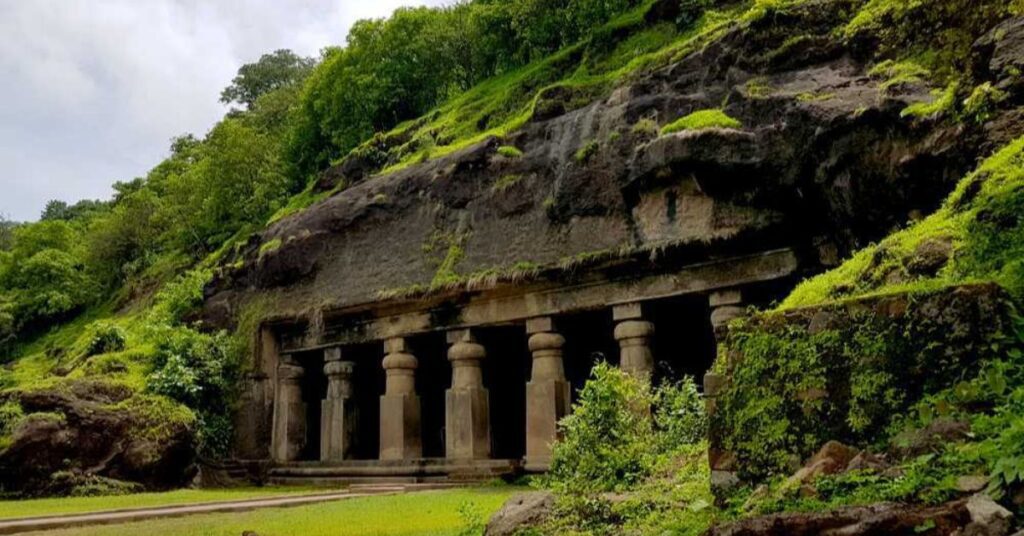Imagine a hidden world carved into the heart of Maharashtra’s stunning landscape. This isn’t fantasy; it’s the Elephanta Caves, a breathtaking testament to the region’s rich cultural heritage and artistic brilliance. Located on a captivating island just a ferry ride from Mumbai’s bustling chaos, these ancient rock-cut caves whisper stories from the 5th to 8th centuries AD.
Step inside and marvel at exquisite sculptures and intricately carved panels depicting Hindu deities, especially the awe-inspiring depiction of Lord Shiva in various mythological forms. Designated a UNESCO World Heritage Site, the Elephanta Caves hold a mystical aura, transporting you back in time.
How to reach:
Public Transport to Elephanta Caves:
Mumbai Starting Point:
- Local Train: Take the Western Line to Churchgate Station. From there, it’s a short walk (around 1.5 km) or a taxi ride to the Gateway of India.
- Bus: Several buses from various Mumbai locations (Colaba, Churchgate, CST) head to the Gateway of India.
- Taxi/Ride-Sharing: This is the most convenient option. Hail a taxi or use a ride-sharing app to reach the Gateway of India directly.
Gateway of India to Elephanta Caves:
- Ferry: Ferries depart regularly for Elephanta Island, with a journey time of roughly 1 hour. Schedules vary, so check for timings before your trip. Ferries operate from early morning to evening.
On Elephanta Island:
- Walk: The caves are about a 1 km walk from the jetty where the ferry arrives.
- Toy Train/Horse Ride: For those who prefer not to walk, a toy train or horse ride takes you to the cave entrance (optional).
Best time to visit:
Pleasant Exploration (November to February):
Winter offers the most comfortable weather for exploring Elephanta Caves. Enjoy mild temperatures (15°C to 30°C) and smooth ferry rides from Mumbai’s Gateway of India. Fewer crowds grace the caves during this season, allowing you to appreciate the intricate sculptures and rock-cut architecture at your own pace. With frequent ferry services, planning a day trip from Mumbai is convenient.
Soak Up the Sun (March to May):
Summer boasts clear skies and longer daylight hours, perfect for exploring the caves and enjoying scenic island views. However, be prepared for hotter temperatures (25°C to 35°C) and higher humidity. Tourist numbers also increase, especially during holidays and weekends, leading to busier ferries and caves.
Tranquil Escape (June to September):
The monsoon transforms Elephanta Island with lush greenery and refreshing showers. While humidity remains high, temperatures cool slightly. This season offers a quieter experience with fewer crowds, ideal for those seeking a more serene exploration. However, ferry schedules might be affected by rough seas, so checking in advance is crucial. The caves and surroundings take on a mystical, misty atmosphere, offering a unique perspective on the ancient art and history.
Attractions:
Main Cave (Cave 1):

Step into the heart of Elephanta Caves – the main cave, a UNESCO World Heritage Site that stuns with its remarkable rock-cut architecture and ancient Hindu sculptures. Dedicated primarily to Lord Shiva, the cave unveils a treasure trove of artistry. The iconic Trimurti sculpture takes center stage – a three-headed masterpiece depicting Shiva’s multifaceted nature. Gaze upon the intricate carvings that represent him as the Creator (Brahma), the Preserver (Vishnu), and the Destroyer (Mahesh, another form of Shiva).
Other Caves (Caves 2 to 5):

While the main cave takes center stage at Elephanta, the island holds more treasures to discover. Tucked away are several smaller caves (Caves 2 to 5), each offering a unique glimpse into the rich tapestry of ancient Indian art and culture. These caves serve as galleries showcasing sculptures of Hindu deities like Shiva, Parvati, Kartikeya, and Ganesha. Imagine encountering celestial beings and scenes from myths depicted on the cave walls.
Cave 2 will impress you with its sculptures of Ardhanarishvara (the combined form of Shiva and Parvati) and Nataraja (Shiva in his cosmic dance pose). Meanwhile, Cave 5 unveils a majestic sculpture of Maheshamurti, a meditative form of Shiva.
Rock-cut Architecture:

Imagine a world sculpted from rock – that’s the magic of Elephanta Caves. Every detail, from intricate reliefs to ornate pillars and stunning sculptures, is a testament to the incredible craftsmanship and engineering skills of ancient India.
These awe-inspiring caves were carved entirely out of solid basalt rock, a feat that speaks volumes of the artisans’ mastery. Their precision in transforming the natural rock formations is breathtaking. The intricate details on the sculptures go beyond mere artistry; they showcase a deep understanding of structural stability, ensuring the caves have withstood centuries.
Elephanta Island:

Elephanta Island isn’t just about the awe-inspiring caves. The island itself offers a tranquil escape from the bustling city of Mumbai. Imagine winding pathways leading you through lush greenery, a world away from the urban chaos. Towering ancient trees and vibrant tropical vegetation create a serene atmosphere, perfect for a leisurely walk and a breath of fresh air. For wildlife enthusiasts, Elephanta Island holds a secret – a haven for native bird species and small mammals that thrive in this unique ecosystem. Keep your eyes peeled – you might spot a flash of color or a curious creature peeking from the undergrowth.
Local Experiences:
1. Dive into Culinary Delights: Mumbai’s street food scene explodes with flavor. Devour vada pav (potato fritters in a bun), savor pav bhaji (thick vegetable curry with bread), and explore the dizzying variety of chaat (savory snacks) at Colaba Causeway or Chowpatty Beach stalls.
2. Shop ‘Til You Drop: Mumbai’s markets are a treasure trove. Hunt for unique souvenirs, handcrafted textiles, traditional jewelry, and quirky finds at bargain prices in Colaba Causeway or the historic Crawford Market.
3. Gateway to Enchantment: The majestic Gateway of India stands as a symbol of Mumbai. Take a boat ride to explore the city’s harbor and nearby attractions like the famed Elephanta Caves. Soak in the stunning Arabian Sea views.
4. Queen’s Necklace Stroll: Enjoy a leisurely walk along Marine Drive, also known as the Queen’s Necklace. This scenic promenade offers breathtaking vistas of the Arabian Sea, especially during sunset. People-watch and soak in the city’s vibrant atmosphere.
5. A Journey Through Time: Step back in time at the Chhatrapati Shivaji Maharaj Vastu Sangrahalaya (formerly Prince of Wales Museum). Explore its fascinating collection of ancient artifacts, sculptures, and art pieces that tell the rich story of India’s history and culture.
6. Lights, Camera, Bollywood! Go behind the scenes of the magical world of Bollywood with a guided studio tour. Learn about filmmaking and maybe even catch a glimpse of your favorite stars!
7. A Different Mumbai: Embark on a guided tour through Dharavi, one of Asia’s largest slums. Witness Mumbai’s vibrant local culture and entrepreneurial spirit firsthand. Choose responsible companies focused on empowerment and education for a respectful experience.
8. Melodies by the Caves: If you’re visiting in February, don’t miss the Elephanta Festival. Immerse yourself in classical music and dance performances held against the majestic backdrop of the Elephanta Caves. It’s a truly unique and unforgettable experience.
9. Relaxation by the Sea: Seeking serenity? Head to Juhu Beach, Mumbai’s most popular stretch of sand. Unwind, take a dip in the Arabian Sea, indulge in delicious street food, or experience the vibrant nightlife scene along the coast.
10. A Spiritual Sanctuary: Visit the Haji Ali Dargah, an iconic mosque and tomb located on a small islet off the coast of Worli in South Mumbai. Admire the architectural marvel and experience a glimpse into Mumbai’s rich cultural tapestry.
Travel tips:
Be in the Know:
- Check It Twice: Before you set sail, confirm ferry schedules and weather conditions, especially during the monsoon season.
- Sturdy Soles: Pack comfortable shoes with good grip for navigating Elephanta Island’s uneven terrain.
Stay Hydrated & Sun-Safe:
- Hydration Hero: Pack plenty of water for your trip, especially during the hot summer months.
- Sun Shield: Don’t forget sunscreen to protect yourself from the strong sun.
Beat the Crowds:
- Early Bird Gets the Cave: Aim to arrive early at the Gateway of India to secure a spot on the first ferry and avoid large crowds.
Cash is King:
- Bring Bills: ATMs on Elephanta Island are limited, so carry enough cash for ferry tickets and other expenses.
Dress Respectfully:
- Cultural Cues: When visiting religious sites like Elephanta Caves and temples, dress modestly and respectfully.
A Taste of Mumbai:
- Savvy Savor: Sample Mumbai’s street food, but choose well-established vendors to avoid any stomach woes. Stick to bottled water and avoid drinks with ice.
Explore Like a Local:
- Public Transport Pro: Mumbai boasts a reliable local train and bus network – a budget-friendly way to navigate the city.
Safety First:
- Keep it Safe: Be mindful of your belongings in crowded areas and opt for authorized transportation services.
Conclusion
Unveiling India’s rich tapestry, a visit to Elephanta Caves in Maharashtra offers a captivating journey documented in detail on Xplro.com. From intricate rock-cut sculptures depicting Hindu deities to the serene island ambiance, this UNESCO World Heritage Site resonates with historical significance and spiritual depth. Explore the iconic Trimurti sculpture in the main cave, marvel at panoramic Arabian Sea views, or simply soak it in – Elephanta Caves promises a memorable experience for history buffs, nature lovers, and cultural explorers alike. Extend your adventure to Mumbai’s vibrant streets, savor local cuisine, and explore iconic landmarks like the Gateway of India. It’s a truly enriching journey showcasing India’s timeless allure, and Xplro.com can be your guide to unlocking the magic of both Mumbai and Elephanta Caves.
FAQs
Where are Elephanta Caves located?
- Elephanta Caves are situated on Elephanta Island (also known as Gharapuri Island), approximately 10 kilometers east of Mumbai’s Gateway of India.
How do I get Elephanta Caves from Mumbai?
- To reach Elephanta Caves, you can take a ferry from Gateway of India in Mumbai. The ferry ride to Elephanta Island takes about 1 hour each way.
What are the opening hours of Elephanta Caves?
- Elephanta Caves are open for visitors every day from 9:00 AM to 5:00 PM, including weekends and public holidays.
What is the entry fee for Elephanta Caves?
- The entry fee for Elephanta Caves is nominal. As of the latest information, Indian nationals are charged ₹40 per person, while foreign tourists pay ₹600 per person.
Are guided tours available at Elephanta Caves?
- Yes, guided tours are offered at Elephanta Caves. Authorized guides can be hired at the entrance to provide insights into the caves’ history, architecture, and cultural significance.
What are the main attractions at Elephanta Caves?
- The main attractions include the Trimurti sculpture in the main cave (Cave 1), various sculptures depicting Hindu deities in other caves, and the impressive rock-cut architecture throughout the site.
Is photography allowed inside Elephanta Caves?
- Yes, visitors are allowed to take photographs inside the caves for personal use. However, the use of flash photography and tripods may be restricted.
What should I wear when visiting Elephanta Caves?
- It is recommended to wear comfortable clothing and sturdy shoes suitable for walking on uneven terrain. Modest attire is advised, especially when visiting religious sites like Elephanta Caves.
Are there facilities like restrooms and food options available on Elephanta Island?
- Yes, basic restroom facilities are available on Elephanta Island. Additionally, there are food stalls near the ferry jetty offering snacks and refreshments.
When is the best time to visit Elephanta Caves?
- The best time to visit Elephanta Caves is during the winter months (November to February) when the weather is pleasant and crowds are fewer. It is advisable to avoid the monsoon season (June to September) due to heavy rainfall and potential ferry disruptions.
Can I combine a visit to Elephanta Caves with other attractions in Mumbai?
- Yes, you can easily combine your visit to Elephanta Caves with exploring other popular landmarks in Mumbai such as the Gateway of India, Marine Drive, and various museums like the Chhatrapati Shivaji Maharaj Vastu Sangrahalaya.
Is Elephanta Caves accessible for elderly or differently-abled visitors?
- While Elephanta Caves involve some walking and climbing stairs, there are options like toy trains or palanquins for hire. However, the terrain may not be fully wheelchair-accessible, so it is advisable to inquire about specific arrangements in advance.




